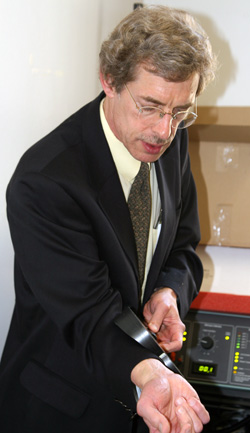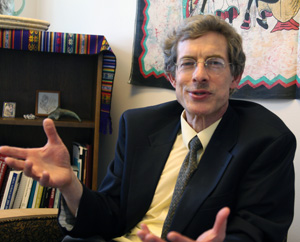Wabash Helped Shape Avery's Study of Lightby Howard W. Hewitt |
| Printer-friendly version | Email this article |
|
SEATTLE, Washington - Dr. David Avery ‘68 has always been fascinated by the connection and differences in science, psychiatry, and religion. Those intellectual challenges started at Wabash and have shaped his career in psychiatry.
Avery is the Director of Inpatient Psychiatry and Professor of Psychiatry and Behavioral Sciences at the University of Washington. He works at the university’s Harborview Medical Center in Seattle.
"My career path began at Wabash," Avery said. "I was a religion major and chemistry minor. I was really intrigued by the mind-biology issue. Obviously, in religion free will is emphasized. In science, the language game doesn’t allow for free will, everything is determined by something else.
"I can remember actually buying a book at the Wabash book store about the effect of changing endocrine function on behavior. It was clear that Biology has a role in terms of influencing behavior, and yet, science can't explain everything, and behavior is much more complex. I think in part, the Wabash experience, the liberal arts experience, really proved to be the starting point for my interest in biological psychiatry."
His interest really grew as he became more fascinated by sleep and circadian rhythms (the body’s 24-hour clock). "Even if you eliminate external factors that influence them, they persist," he said of those cycles. "They are a fundamental part of our biology."
That interest, his own sleeping habit growing up in Portage, Indiana, and coming to Crawfordsville led to his strong feelings about the benefits of morning light and time zones.
"Morning light is the most powerful synchronizer of our circadian rhythms, much more so than evening," he said. Avery noted that Crawfordsville, and all of western Indiana, are on the very edge of the Eastern Time zone. "That means people in Crawfordsville are waking up before the sun is rising. The data would suggest that it’s tough for many people to function under those circumstances. There is a lot of morning drowsiness until the sun rises."
Avery started theorizing about morning light while in college and later did research on the topic that became a big part of his career.
"What happens to kids that have to wake up in the dark," he asked. "We still may do a research project (on SAT scores near the time zone line), if we can get access to the data. That’s one practical aspect of my work."
Of course the obvious wrinkle in his interest is his 1980 move to Seattle – one of the darkest, and often most dreary parts of the country. "It’s a beautiful place in the summer, but in the winter it is very dark. The light period is very short and it’s also very, very cloudy. Even if you wake up and go outside there’s not a real strong light signal.
And the research has a national scope. The National Institute of Mental Health was doing similar research in the 80s when Avery was beginning to probe the issue.
Those suffering from winter depression are often treated with light boxes and even a simpler recommendation of getting early morning light. It’s a treatment Avery suggests for everyone.
"There is an association between positive mood and people who tend to wake up earlier," he said. "In our modern world we tend to create very erratic light and dark contrasts. We have the computer on late in the evening, and we turn off all the lights just before bed. On Fridays and Saturdays we stay up late and sleep in a dark bedroom a little later and that creates a jet lag situation. I just think regular morning light is probably a good thing for most people to do."
His research now is more centered on magnetic stimulation as a treatment for depression and mental health disorders as opposed to electronic stimulation which has been used for decades. Electronic stimulation could result in a 30-day memory loss before and after the treatment. The magnetic treatment does not cause any side effects.
Avery knows such treatments have been highly controversial and dramatized in movies like One Flew Over the Cuckoo’s Nest. "But the data says that’s the most effective treatment for severe depression."
Armed with a grant from the National Institute of Mental Health, Avery has explored the benefits of magnetic stimulation. He demonstrated it in his office with absolutely no physical discomfort or side effect.
He wants to think more about religion as he nears retirement and possibly do research in the area. "I’m very interested in comparative religion, and the huge overlap in terms of religion and common beliefs."
Those interests could lead Avery into more post-career writing. He’s considering publishing papers or maybe a book, of his thoughts on psychology and religion. He used to hike and run up in the mountains more than he does now. And he enjoys his adult children and sharing in their lives. What’s he most proud of from his distinguished career?
"My family," he said and smiled. "I have two girls, one boy 20, 24, 21. One's a psychologist, my son is in his first year of medical school, and my other daughter just graduated from Whitman College with a degree in anthropology. She'll probably end up as a social worker or public health. Is there any other answer?"
In Photos: Dr. David Avery at Harborview Medical Center in Seattle. At top left, he demonstrates how the magnetic treatment pad works.
|

 Through his work and research, Avery has become one of the nation’s leading authorities on Seasonal Affective Disorders. His work has led him to become a frequently-quoted source on winter depression and also one of the leading advocates to move Indiana from the Eastern to Central time zone.
Through his work and research, Avery has become one of the nation’s leading authorities on Seasonal Affective Disorders. His work has led him to become a frequently-quoted source on winter depression and also one of the leading advocates to move Indiana from the Eastern to Central time zone. "I don’t think it’s an accident that this is where Starbucks began. I think a number of people found that they really needed some coffee as a drug each morning."
"I don’t think it’s an accident that this is where Starbucks began. I think a number of people found that they really needed some coffee as a drug each morning."